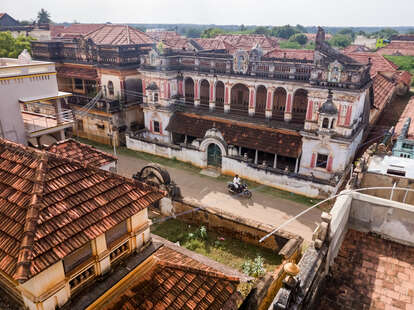India’s Crumbling Mansions Yield Some of the World’s Best Antiquing
Find unexpected treasures in Chettinad.
Deep in the heart of South India, hours away from any major cities, lies a collection of decaying mansions. Their palatial exteriors are adorned with gold and silver decorations and handmade tiles, the vast interiors filled with teak wood, Venetian chandeliers, mahogany-framed mirrors, and Swiss grandfather clocks. These worn and faded homes tell a story of opulence, status, and wealth dating back several hundred years, a fascinating glimpse into a bygone era when one of the last of India’s wealthy merchant classes turned the seemingly obscure region of Chettinad into a hub of commerce. But today, these ruins fuel a different kind of commerce, the mansions serving as a treasure trove for antique dealers, collectors, interior designers, and even history buffs who want to fill their homes with mementos of the past.
When the mansions were new, this area was considered the home ground of India’s southern royalty: the Chettiars. Chettinad was one of the richest areas of the country during Britain’s colonial reign in the 1850s to 1940s. The merchants traded with numerous neighboring countries, such as Burma (now Myanmar), Indonesia, Ceylon (now Sri Lanka), and Vietnam, and built opulent mansions to showcase all their wealth. In fact, the bigger the home, the more prosperous the family. Each house occupied the length of the entire street with high boundary walls, facades decorated with stucco figurines, colorful murals, and ornamental balustrades. The floors were composed of athangudi tiles handmade by the famous artisans from the neighboring town. Over the centuries, more than 15,000 homes were built, each spread over an area as large as one and a half acres and often filled with decor purchased overseas.
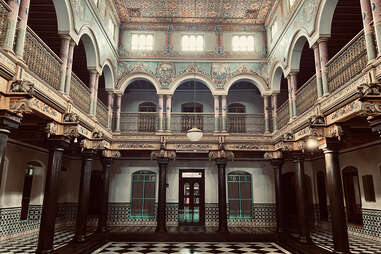
These days, many of these elaborate mansions are in decay. Some are still owned by the original ancestral families, but abandoned due to the astronomical cost of upkeep. Others, like Chettinadu Mansion and Chidambara Vilas, have been converted into heritage hotels. Under India’s Ancient Monuments And Archaeological Sites and Remains Act of 1958, the hotels retain much of the structure and decor for guests to enjoy. Still other abandoned homes have no real resale value, except as salvage, in part due to their location. Chettinad is essentially in the middle of nowhere, deep in rural agricultural India, where the nearest airport (in Madurai) is almost two hours away.
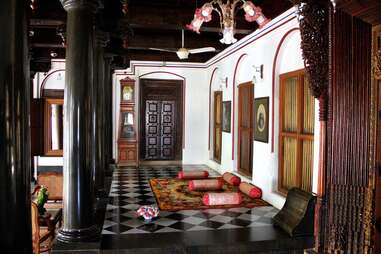
But despite Chettinad’s remote location, the region is a dream for antiquers. Studio One by Zero, an architecture and interior design firm based in Chennai, uses these objects to incorporate the history and art of Chettinad mansions into projects. Its architects cite intricately carved wooden doors, furniture made of wood and metal, and columns with decorative bases as some of the palaces’ most famous antiques.
“We also love metal statues and colorful enamel-coated utensils that the merchants collected from Sweden, Czech Republic, and Slovakia, along with colorful Japanese tiles and Martaban jars from China and Burma,” says Kavya Rajendra, an architect at Studio One by Zero. “I love looking for large pieces such as a wooden horse which I can place in front a mirror at the entrance foyer, or a Garuda (Hindu deity) statue on a wooden rice pounder.”
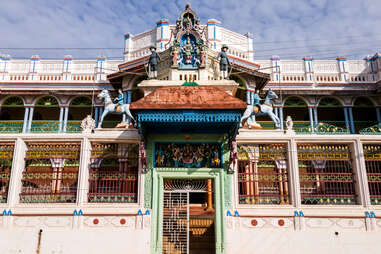
The antique market in the neighboring Karaikudi, just 20 minutes from Chettinad, is a must-visit for those interested in purchasing a diverse range of items, from small antique pieces to nine-foot doors. Muneeswaran Koil Road, a quaint bylane in the town, houses a variety of shops such as Old Chettinad Crafters and Karaikudi Antiques Market. Usually most of the shop owners have warehouses close by where they store some rarer pieces. “You just have to ask if they have anything else to showcase and more often than not, they will happily oblige,” notes Rajendra.
For those who choose to make the pilgrimage to these antique stores, a little knowledge will go a long way when it comes to locating and purchasing real treasures. For example, Rajenda says, “Kavadi panels (intricately carved wooden panels used for religious practices many decades ago) are rare to find and difficult to replicate, making them some of the most exotic and expensive antiques that you can buy here.” A fake should be apparent. And along the same lines, steer clear of colorful statues that show no signs of distressed paint, chips, or use. According to Rajendra, “some vendors may claim to have retouched the antique and painted it again, but this usually means it's a new piece.”
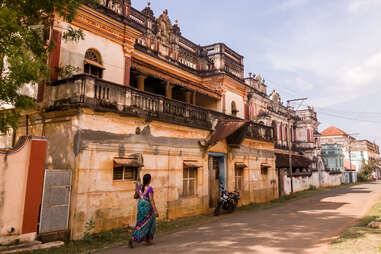
Once you’ve found an item you want to buy, it’s time to negotiate. “You can get many of the antiques at amazing prices if you take the time to look around and bargain,” says Vanathi Gururaj who was born in Karaikudi and now lives in Bangalore. She enjoys shopping for small figurines, old brass kitchen tools, and utensils. The antique stores brim with brass cutlery, trays, multi-tiered lunch boxes, milk cans, and cups, since brass—considered auspicious in Indian culture—was the metal of choice for most kitchenware at that time. “Some of the really old ones have the owner’s names etched in Tamil and that brings another element of authenticity to these old dishes,” explains Gururaj. "Growing up in this area, I know the history of many of these homes, so it is particularly joyful when I can bring back a piece for myself or to give as gifts.”
For those who are less familiar with the area, it can be helpful to have a local like Gururaj accompany you during your trip.“They hold a deep passion for the area’s culture and will help you take time to understand the history and heritage of these mansions, which will definitely help in appreciating these rare and unique gems,” says Rajendra.
The life of this community has shaped much of the narrative of this area and these heritage homes are testimony to that story. “And having an item from Chettinad means you are now a custodian of that story,” says Gururaj. “So, own it, display it and appreciate it proudly.”
